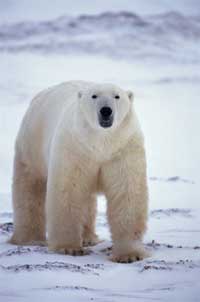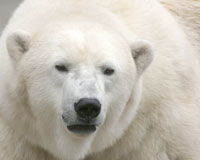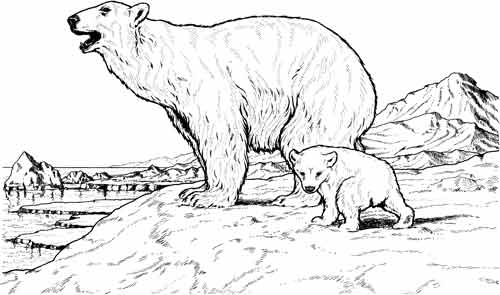|

 Sizes and Scales: The Polar bear is the largest living land carnivore, twice the weight of a Siberian tiger. Most adult males weigh from 400 to 600 kg (880 to 1300 lb) and exceptionally, up to 800 kg (1750 lb). The Kodiak sub-species of the Brown bear, an omnivore, is sometimes as large. The largest Polar bear on record was shot at Kotzebue Sound, Alaska in 1960. This male was estimated to weigh about 880 kg (1960 lb). Mounted, it stood 3.38 m (11 ft 11 in) high. Sizes and Scales: The Polar bear is the largest living land carnivore, twice the weight of a Siberian tiger. Most adult males weigh from 400 to 600 kg (880 to 1300 lb) and exceptionally, up to 800 kg (1750 lb). The Kodiak sub-species of the Brown bear, an omnivore, is sometimes as large. The largest Polar bear on record was shot at Kotzebue Sound, Alaska in 1960. This male was estimated to weigh about 880 kg (1960 lb). Mounted, it stood 3.38 m (11 ft 11 in) high.
Females are about half the size of males and normally weigh 200 to 300 kg (450 to 650 lb). Adult males measure 2.4 to 2.6 m (95 to 102 in); females, 1.9 to 2.1 m (75 to 83 in). At birth, cubs weigh 600 to 700 g.
A Polar bear's nose and skin are black and the fur is translucent despite its apparent white hue. The fur is good camouflage as well as insulation. Stiff hairs grow on the soles of its paws; these insulate and provide traction on ice.
 Fiber-optic Fur: Unlike other arctic mammals, Polar bears never shed their coat for a darker shade in the summer. The fur absorbs ultraviolet light. The hair does not have fiber-optic properties nor does it transmit light or heat to the skin (an urban legend). The thick undercoat does however insulate the bears to the point where they overheat at temperatures above 10 °C (50 °F). It also renders them nearly invisible in the infrared; only their breath and muzzles can be seen. Growing through the undercoat is a relatively sparse covering of hollow guard hairs about 6 inches long. These guard hairs are stiff, shiny and erect, and stop the undercoat from matting when wet. The water is then easily shaken off before it can freeze. The bear also rolls in snow to blot up moisture in the coat. Fiber-optic Fur: Unlike other arctic mammals, Polar bears never shed their coat for a darker shade in the summer. The fur absorbs ultraviolet light. The hair does not have fiber-optic properties nor does it transmit light or heat to the skin (an urban legend). The thick undercoat does however insulate the bears to the point where they overheat at temperatures above 10 °C (50 °F). It also renders them nearly invisible in the infrared; only their breath and muzzles can be seen. Growing through the undercoat is a relatively sparse covering of hollow guard hairs about 6 inches long. These guard hairs are stiff, shiny and erect, and stop the undercoat from matting when wet. The water is then easily shaken off before it can freeze. The bear also rolls in snow to blot up moisture in the coat.

 Deadly Diet: It is the most carnivorous member of the bear family, and the one that is most likely to prey on humans as food. It feeds mainly on seals, especially Ringed seals that poke holes in the ice to breathe, but will eat anything it can kill: birds, rodents, shellfish, crabs, seals, Beluga whales, walruses, occasionally Musk Oxen, and very occasionally other Polar bears. Deadly Diet: It is the most carnivorous member of the bear family, and the one that is most likely to prey on humans as food. It feeds mainly on seals, especially Ringed seals that poke holes in the ice to breathe, but will eat anything it can kill: birds, rodents, shellfish, crabs, seals, Beluga whales, walruses, occasionally Musk Oxen, and very occasionally other Polar bears.
Surf and Turf: Polar bears are excellent swimmers and can often be seen in open waters miles from land. This may be a sign that they have begun aquatic adaptations to better catch their prey, although recent evidence indicates that they may be drowning in the open sea because global warming is melting the ice shelves that previously made up their homes. They also hunt very efficiently on land due to their prodigious speed; they are more than capable of outrunning a human. Still, caribou and musk oxen easily outrun a Polar bear, and Polar bears overheat quickly; thus the Polar bear subsists almost totally on seals and on walrus calves or adult carcasses.
Vitamin A:As a carnivore feeding largely upon fish-eating carnivores, the Polar Bear ingests large amounts of Vitamin A, which is stored in its liver; in the past, humans have been poisoned by eating Polar Bear liver. Although largely carnivorous, they will also feed on carrion (e.g. beached whales) and also eat some vegetable matter, mainly berries and roots in the late summer, as well as kelp.
Warning: Polar bears are aggressive, curious, and extremely dangerous to humans. A Polar bear should never be approached and if one is spotted, it is best to retreat slowly on foot, preferably to indoors, or move away in a vehicle.
Garbage Pale Kids: Regrettably, like other species of bear, they have developed a liking for garbage; the dump in Churchill, Manitoba is frequently scavenged by Polar Bears, who have been observed eating (among other things) grease and motor oil.

 Cuddly Cubs: Polar bears mate in the spring; pairing is temporary, only lasting for the mating with no permanent bond between males and females. The gestation period is 240 days (8 months), with the cubs born in early winter in a cave dug in October by the mother in deep snow. Cuddly Cubs: Polar bears mate in the spring; pairing is temporary, only lasting for the mating with no permanent bond between males and females. The gestation period is 240 days (8 months), with the cubs born in early winter in a cave dug in October by the mother in deep snow.
Tiny Babies: Usually, two cubs are born, less often one or three; litters of four cubs have been recorded. As with other Ursus bears, the cubs are very small at birth, typically 30 cm long and weighing 700 g. The cubs are born nearly helpless and blind, opening their eyes at about one month old, able to walk at 1.5 months, and start eating solid food at 4-5 months.
Elementary Education: They remain with their mother, learning how to hunt and protect themselves against adult males (which have been known to cannibalize cubs), until 10 months old. Females nurse their young for up to two and a half years on milk that contains approximately 33% fat, higher than that of any other species of bear and comparable to that of marine mammals. Sexual maturity is reached at 3-4 years. Adult Polar bears are known to live to over 30 years.
Hibernate Hibernot: Polar bears do not hibernate, though the lactating females will not emerge from their cave while the cubs are very young. The mother will not have eaten for nine months, thus relying on stored body fat also known as blubber for both her own nutrition and that of the cubs.
One of the largest Polar bear denning sites is located in Wapusk National Park on the coast of Hudson Bay in Canada.

The Polar bear is a circumpolar species found in and around the Arctic Ocean whose southern range limits are determined by pack ice (its southernmost point is James Bay in Canada). While their numbers thin north of 88 degrees, there is evidence of Polar bears all the way across the Arctic. Population estimates are generally just over 20,000.
Their main population centers are:
* Wrangel Island and western Alaska
* Northern Alaska
* Canadian Arctic archipelago
* Greenland
* Svalbard-Franz Josef Land
* North-Central Siberia
Their range is limited by the availability of sea ice that they use as a platform to hunt seal, the mainstay of their diet. The destruction of its habitat on the Arctic ice, which may be caused by global warming, threatens the bear's survival as a species; it may become extinct within the century. Signs of this have already been observed at the southern edges of its range.

All text is available under the terms
of the GNU Free Documentation License
|